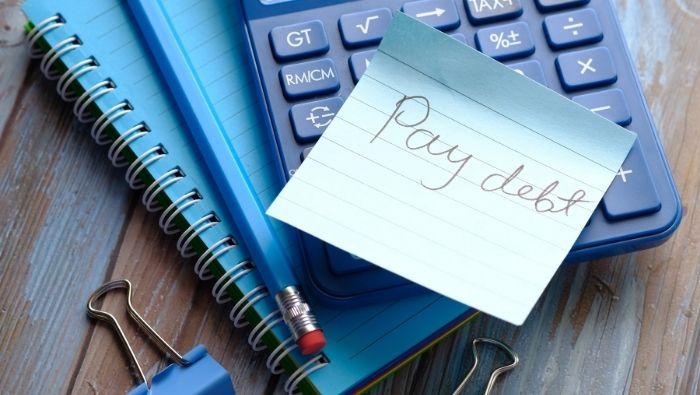Guidelines for Calculating and Budgeting Debt Repayment
by Gary Foreman

Take these steps to calculate how much you need to pay towards your debt each month to actually make a dent and how to work that payment into your monthly budget.
Dear Dollar Stretcher,
They say rent should be a certain percentage of your salary and that other budget categories should not be more than a certain percentage. How much should be allocated to credit card debt if you made the mistake of getting into debt?
If I paid each credit card a little bit, I’d still owe about $400 a month. How do I figure out what my income should be to pay that much each month but still not be in trouble? For instance, if I only earned $2,500 a month, I determined I couldn’t pay rent, food, etc., and my credit cards. However, if I made $100,000 a year, I could cover the additional $400 a month.
Is there a way to calculate this?
Linda
Linda asks a good question. How much debt repayment can I fit into my budget?
And, yes, she’s right. Someone with a $100,000 annual income can afford more than someone who takes home $2,500 each month.
So, let’s see if we can’t come up with some debt repayment guidelines for Linda.
Calculating Debt Repayment
Most family budgets are dominated by three categories: housing, auto and food. Combined, they typically take up 65 to 70% of the budget.
That leaves 30 to 35% for everything else: insurance, clothing, medical, dental, entertainment and vacations, education, property taxes, savings, and debt repayment. Most of these categories will require between 3% and 7%, which will quickly consume the remaining portion of your income.
Each family is a little different, but most families can commit about 5% of their paycheck to repaying debt without twisting their budget out of shape.
Sign Up for Savings
Subscribe to get money-saving content by email that can help you stretch your dollars further.
Twice each week, you'll receive articles and tips that can help you free up and keep more of your hard-earned money, even on the tightest of budgets.
We respect your privacy. Unsubscribe at any time.
Budgeting Debt Repayment
How does that work out in Linda’s case? A monthly payment of $400 is 5% of $8,000. So Linda would need to bring home $8,000 after taxes to hold to this budget. I hope that she is making $96,000 a year, but there’s a good chance that she’s not. So, she might need to make some adjustments.
Even if she is making that much money, it’s still wise to pay down her credit card balance. That’s because it is unlikely to stay at the current level. The reason is simple. Life happens. There will always be “unexpected” home and auto repair bills. Even with good medical insurance, the deductible on a broken arm can be significant. And taking a nice vacation is really tempting.
If Linda is struggling already, she probably doesn’t have money saved for these emergencies. So they’ll go on her credit card. And that will boost her balance. The new minimum will only go up a little bit, but the hill she’s climbing just got a little steeper.
Related: Reduce Your Debt With a Sinking Fund
The sad part is that many people fall into credit card debt because they can’t afford to completely pay for whatever they bought during the month. The trouble is that the interest they’ll owe only makes the original purchase more expensive. So they’ll pay even more for something that they couldn’t afford in the first place.
Finding the Extra Money You’ll Need for Debt Repayment If Your Budget Falls Short
So what can Linda do? Take aggressive steps to pay down her credit card balance. Beginning now. The biggest opportunities are where she spends the most: housing, auto and food. It may be time to move to a smaller home or apartment or take in a roommate. Replace an expensive car with a cheaper one. Commit to eating at home until her debt is paid off.
Linda should also look for ways to make small contributions to her “debt repayment fund.” It’s time to consider dropping premium cable channels, mocha lattes and other non-essentials. You’d be surprised how quickly these items can add up to a sizeable amount. Not only will she be reducing debt, but also she’ll feel better about taking steps to reach her goal.
Drastic Debt, Drastic Measures
Some of these may seem overly drastic, but they are meant to be drastic. Linda is heading for a financial wreck. Here’s how it will unfold. “Unexpected” expenses will add to her balance and her monthly minimum. If her minimum payments begin to exceed 5% of her budget, she’ll soon find herself unable to make the monthly payment.
Then, things will snowball. Each month, she’ll struggle to make all the minimum payments on time. One day, a payment will be a little late. Her interest rates will go up on all of her cards. That’ll increase her minimum payment. That, in turn, will make it almost impossible to cover the new minimums. Her credit rating will go down. She’ll trigger a chain of events that will take up to ten years to correct.
Linda might be at the point where she needs professional help if she hopes to get out of debt. It might be wise for her to determine if she is eligible for credit counseling.
Get Help Paying Off Credit Card Debt
Use these guidelines to choose the best plan to pay off your credit card balances.
Linda is wise to correct it now while she still has time. Some of the steps she’ll need to take will be painful. But she’ll be avoiding much more financial pain in the future.
Reviewed December 2023
About the Author
Gary Foreman is the former owner and editor of The Dollar Stretcher. He's the author of How to Conquer Debt No Matter How Much You Have and has been featured in MSN Money, Yahoo Finance, Fox Business, The Nightly Business Report, US News Money, Credit.com and CreditCards.com.
Sign Up for Savings
Subscribe to get money-saving content by email that can help you stretch your dollars further.
Twice each week, you'll receive articles and tips that can help you free up and keep more of your hard-earned money, even on the tightest of budgets.
We respect your privacy. Unsubscribe at any time.
Popular Articles
- 7 Habits of Highly Frugal People
- 5 Simple Budget Cuts That Can Save $200 a Month
- How to Track Down Unclaimed Funds Owed You
- 32 Ways to Save Money on Your Utility Bills
- Do You Need Credit Life Insurance When Buying a New Car?
- How to Maximize Profits When Selling Online
- Staying Motivated to Continue Digging Yourself Out of Debt
On After50Finances.com
- 9 Things You Need to Do Before You Retire
- You Didn’t Save Enough for Retirement and You’re 55+
- When Empty Nesters Reorganize and Declutter Their Home
- Reinventing Your Career in Your 50s or 60s
- What Mature Homeowners Should Know about Reverse Mortgages
- 2 Reasons to Collect Social Security Benefits As Soon As Possible


